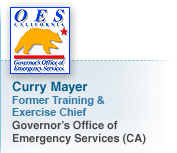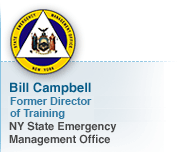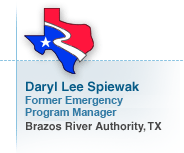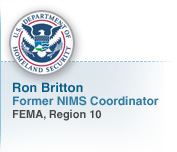Curry Mayer, Former Training & Exercise Chief, Governor’s Office of Emergency Services (CA)
Public information is of course important in any event, and NIMS emphasizes that public information in a large event be coordinated so that all those entities—either jurisdictions, agencies, or levels of government—those Public Information Officers come together and have a joint message. So different agencies that, it might be that you have, you know, transportation and food and agriculture that are involved in the event so what are, what those public, the public information message, although one coordinated message needs to include the elements from those different agencies that are involved, and who are the stakeholders, who are the people that have been impacted, and ensuring that your message is coordinated so that everyone that needs to have some kind of information about the event gets what they need from that. The new thing for NIMS is that each level of government and each agency involved has a public information responsibility, but they come together and have one, one message that comes out.
Bill Campbell, Former Director of Training, NY State Emergency Management Office
Public information is number one, it’s one of the command staff positions within the ICS structures so that tells you right up front that in the incident command system we place a lot of emphasis on public information and information in general. I think the importance and significance of public information is higher and greater now than it’s ever been in our history. You’ve got to have a coordinated way to get a consistent message out. We’ve got to be very clear and concise in our message to the public as to what we want them to do. Public information is more than just the public, it’s also the response community too.
Daryl Lee Spiewak, Former Emergency Programs Manager, Brazos River Authority, TX
We need to have a single point of contact for the media so that we can get our information out to the general public. We use the media to get our message out. The citizens of our jurisdiction expect information from us. They want to know what we’re doing, want to know why we are doing things, and more important they want to know what they should be doing. We also found out that if the media isn’t kept in the loop, they are going to go out and start finding stories themselves, finding out information themselves, that means then that we are losing control of the message. The message is being developed by the individual reporters in the media and that’s going to start confusing our citizens and get the wrong message to them. We need a coordinated effort for public information for the safety of the public and the security of the public and that’s what public information allows us to do.
Ron Britton, Former NIMS Coordinator, FEMA, Region 10
Public information is for public safety. We really want that information for people in the environs as well as people who are part of the response community to know what the situation is. They need to know that to stay safe and to perform best. It can also be used to establish information exchanged with the local public to know evacuation routes, where the hospitals they should go to—any number of things that would be of safety interest to the public. One of the reasons it was developed was to provide a consistent message so that different people in different parts of the organization aren’t reporting just what they are seeing, but that there is a centralized system that allows that information to be one-stop shopping and one message that goes out to the public to keep everyone informed, and that’s all very, very safety related, and I think that’s a real key point.









